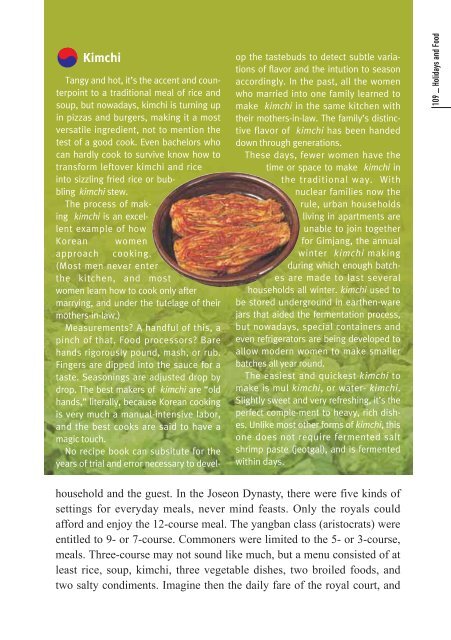HELLO from KOREA
Hello-Eng(3.3) - Korea.net
Hello-Eng(3.3) - Korea.net
- No tags were found...
Create successful ePaper yourself
Turn your PDF publications into a flip-book with our unique Google optimized e-Paper software.
Kimchi<br />
Tangy and hot, it’s the accent and counterpoint<br />
to a traditional meal of rice and<br />
soup, but nowadays, kimchi is turning up<br />
in pizzas and burgers, making it a most<br />
versatile ingredient, not to mention the<br />
test of a good cook. Even bachelors who<br />
can hardly cook to survive know how to<br />
transform leftover kimchi and rice<br />
into sizzling fried rice or bubbling<br />
kimchi stew.<br />
The process of making<br />
kimchi is an excellent<br />
example of how<br />
Korean women<br />
approach cooking.<br />
(Most men never enter<br />
the kitchen, and most<br />
women learn how to cook only after<br />
marrying, and under the tutelage of their<br />
mothers-in-law.)<br />
Measurements? A handful of this, a<br />
pinch of that. Food processors? Bare<br />
hands rigorously pound, mash, or rub.<br />
Fingers are dipped into the sauce for a<br />
taste. Seasonings are adjusted drop by<br />
drop. The best makers of kimchi are “old<br />
hands,” literally, because Korean cooking<br />
is very much a manual-intensive labor,<br />
and the best cooks are said to have a<br />
magic touch.<br />
No recipe book can subsitute for the<br />
years of trial and error necessary to develop<br />
the tastebuds to detect subtle variations<br />
of flavor and the intution to season<br />
accordingly. In the past, all the women<br />
who married into one family learned to<br />
make kimchi in the same kitchen with<br />
their mothers-in-law. The family’s distinctive<br />
flavor of kimchi has been handed<br />
down through generations.<br />
These days, fewer women have the<br />
time or space to make kimchi in<br />
the traditional way. With<br />
nuclear families now the<br />
rule, urban households<br />
living in apartments are<br />
unable to join together<br />
for Gimjang, the annual<br />
winter kimchi making<br />
during which enough batches<br />
are made to last several<br />
households all winter. kimchi used to<br />
be stored underground in earthen-ware<br />
jars that aided the fermentation process,<br />
but nowadays, special containers and<br />
even refrigerators are being developed to<br />
allow modern women to make smaller<br />
batches all year round.<br />
The easiest and quickest kimchi to<br />
make is mul kimchi, or water- kimchi.<br />
Slightly sweet and very refreshing, it’s the<br />
perfect comple-ment to heavy, rich dishes.<br />
Unlike most other forms of kimchi, this<br />
one does not require fermented salt<br />
shrimp paste (jeotgal), and is fermented<br />
within days.<br />
109 _ Holidays and Food<br />
household and the guest. In the Joseon Dynasty, there were five kinds of<br />
settings for everyday meals, never mind feasts. Only the royals could<br />
afford and enjoy the 12-course meal. The yangban class (aristocrats) were<br />
entitled to 9- or 7-course. Commoners were limited to the 5- or 3-course,<br />
meals. Three-course may not sound like much, but a menu consisted of at<br />
least rice, soup, kimchi, three vegetable dishes, two broiled foods, and<br />
two salty condiments. Imagine then the daily fare of the royal court, and
















